As I reach the end of my E-Marketing course #sauder464, many of my classmates and I must be wondering if it is worth it? The median salary is around $43,400. Interestingly, the salary increases respective to the number of employees in the business; for those up to 100 employees, salary averages to $40,900 and for those above 1,000 averages to $58,400.
Bellow are some figures and competitive yearly salaries for the vast roles within digital marketing:
- Internet Marketing Director → $97,400
- Digital Strategist → $63,800
- Content Marketing Manager → $63,600
- Marketing Manager → $62,900
- Public Relations Manager → $61,100
- Online Community Manager → $47,800
- Social Media Strategist → $46,800
- Online Marketing Specialist → $45,600
- Digital Media Specialist → $44,000
- Social Media Manager → $43,800

A career path in social media can certainly promise a nice and lucrative path. It is dutiful to note that entry-level positions start at around $30,000 with median salaries being around $50,000 and $70,000. As seen above, however, as a social media marketer further develops its skills and expertise, it can raise to close to a six figures salary. There certainly is great prospect for social media marketers as more the trend for corporate adoption just keeps growing and higher demand appears.
Nonetheless, there are also some drawbacks and misconceptions about social media. Given the every rising instant connectivity, the job no longer works within the confines of a 9-to-5, and more importantly, that it is not all random, but rather there strategy and analysis involved that drive each tweet, post and social media campaigns.
Sources:
– 10 Top Jobs by Salary for Social Media Pros
– I want to be a social media manager, what will my salary be?
Further Readings:
– Average Salary for Skill: Social Media Marketing
– How Much Should You Pay a Social Media Manager?

 Twitter does a great work with incorporating native ads into its platform. With a simple “promoted” tag, the tweets, trending hashtags, and suggested channels are incorporated in the twitter feeds of its users. Moreover third party resources such as MoPub allow marketers to strategically coordinate the time and repetitive cycle of the promoted ads. This further functionalities help ensure that the user experience is not overcrowded with ads. Most importantly, it allows marketers to place content where users are actively playing attention to and providing content that is aimed to enhance the user experience versus diminish it.
Twitter does a great work with incorporating native ads into its platform. With a simple “promoted” tag, the tweets, trending hashtags, and suggested channels are incorporated in the twitter feeds of its users. Moreover third party resources such as MoPub allow marketers to strategically coordinate the time and repetitive cycle of the promoted ads. This further functionalities help ensure that the user experience is not overcrowded with ads. Most importantly, it allows marketers to place content where users are actively playing attention to and providing content that is aimed to enhance the user experience versus diminish it.
 Which many brands have hastily picked up already, but one in particular that I would like to put on the spotlight is HootSuite. In regards to content marketing, HootSuite does a great job in stirring the focus away from directly selling its social media management system, but rather seeks to provide the value that its target consumers are looking for – how to become better social media experts. Of course, HootSuite weaves its product and services into the articles and up-sells its product as an complimentary enabling tool to that tips and insights that the brand provides.
Which many brands have hastily picked up already, but one in particular that I would like to put on the spotlight is HootSuite. In regards to content marketing, HootSuite does a great job in stirring the focus away from directly selling its social media management system, but rather seeks to provide the value that its target consumers are looking for – how to become better social media experts. Of course, HootSuite weaves its product and services into the articles and up-sells its product as an complimentary enabling tool to that tips and insights that the brand provides.